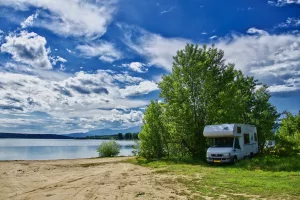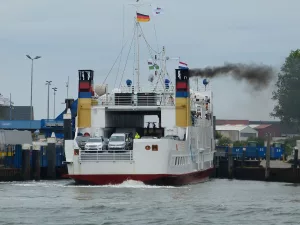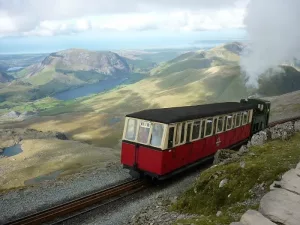Travelling to France - Travel Hub
Our French neighbours bring feelings of warmth and comfort, a love hate relationship to many! Travelling to France in your motorhome is just a wonderful experience – especially to those that are new to motorhoming. France is a fantastic place to travel to in your motorhome. France itself has everything from cosmopolitan cities, historical chateaus, the finest cuisine and stunningly beautiful countryside.
But the best thing – France is incredibly motorhome friendly. France is set up to make motorhoming and road trips so easy! From campsites to Aires and availability for low cost waste and grey water disposal as well as filling up your water tank – all for a few euros.
Travelling to France will be much easier after you have read our handy French travel guide. It will give you all the practical and essential information that you need to know before you go. From what sim card you need, how to take your pet to France with you and the rules on wild camping. So buckle up and lets kick your road trip planning for travelling to France, off to a good start.
France Travel Hub - Jump To
Key Facts - Our French Essentials
Language
French, spoken all over the country and many speak good English too.
Currency
In France they use the single European currency of Euro and Cents.
Schengen
France is part of the Schengen region, (it counts as part of your 90 days free visa travel)
Time Zone
France is in the Central European Timezone, which is GMT +1
ATM & Credit Cards
French ATMs are plentiful. Credit Cards are widely accepted.
Plugs and Voltage
C and E plug types (both 2 round pins). Type E has male socket hole, 230 standard voltage and 50 Hz.
Tipping
Not necessary although shows appreciation. All items have 15% added to the actual item price (not on top of the bill).
Visa
UK travellers need a passport and from 2024 need a ETIAS (electronic visa). Schengen countries travel visa free.
Female Travel
Perfectly safe as a female travel. Take usual precautions in the big cities at night time.
Health
GHIC card will give you emergency cover or state healthcare. Advise Travel Insurance Policy too.
Motorhome Parking
Good range of Aires and campsites. Wild camping is legal - but follow the rules.
French Roads
A mixture of toll roads (A), old national roads (N) and Departmental Roads (D).
Best Travel Months
Spring/Autumn for less crowds, Summer for warmth, Winter for Ski and Christmas Markets
LPG Available
Readily available but you might need an attendant to 'turn it on'. You can't always 'just fill up'
Airports
Top 5 Airports - Paris - Charles de Gualle, Paris Orly, Nice Côte d'Azur, Marseilles, Lyon Saint-Exupéry
Motorhome/ Car Insurance
Likely to be covered as it is an EU and Schengen country - check with your insurance company to be sure.
Tipping
Not required. 15% Service Charge is added to every bill. Living wage is paid to staff.
Emergency Numbers
Emergency - 112 (Fire, Police and Ambulance) Hard of Hearing - 114, 15 - Medical, 17 - Police, 18 - Fire
Pets
Must be microchipped. Must have Rabies injection. Animal Health Certificate (for each trip!)
Traditional Food
French Onion Soup
Bouillabaisse
Croque monsieur
Escargots de Bourgogne
Croissants!
Why Visit France?
Exploring France in a motorhome is an awesome way to see what this country has to offer. France isn’t just one place; it’s beaches, mountains, vineyards, and cities all rolled into one. And with a motorhome, you can see them all at your own pace. France is also really easy to get to from the south of England.
France is great for motorhome travel because it’s set up for it. There are plenty of places to park and stay, from fancy campsites to simple spots just for motorhomes. This makes it easy to travel around, whether you want to see the famous French Riviera, the Alps, or small villages.
One of the best parts of travelling this way is the food. Each part of France has its own special dishes and wines. You can go from tasting seafood in Normandy to trying cheeses in the Loire Valley. And since you’re in a motorhome, you can shop at local markets and cook your finds right there. Even the supermarkets are just amazing! The first French supermarket we stopped at just for something simply, we ended up buying so much stuff, it really is a food lovers dream!
Travelling in a motorhome also means you get to meet locals and see how they live, which is something you might miss if you were just passing through quickly. Plus, France has a lot of beautiful routes perfect for driving, like the Route des Grandes Alpes or through the wine country. The tolerance for motorhomers is completely different from the reception that you receive in the UK. It really is so refreshing.
So, if you’re looking for a road trip that lets you see loads of different things, eat great food, and meet new people, doing it in a motorhome in France is a smart choice. It’s about freedom, comfort, and adventure, all at once.
Download our Handy Road Trip Planner
Use our handy ready made PDF planner to help you plan your trip. We created a 9 day planner to use to plan a 1 week trip. Simply print out more copies for each week of your travels. Capture everything you need from your start and end points to where you will stay. There is space to write all the things you want to see and more. Plenty of room for jotting down notes as you plan too.
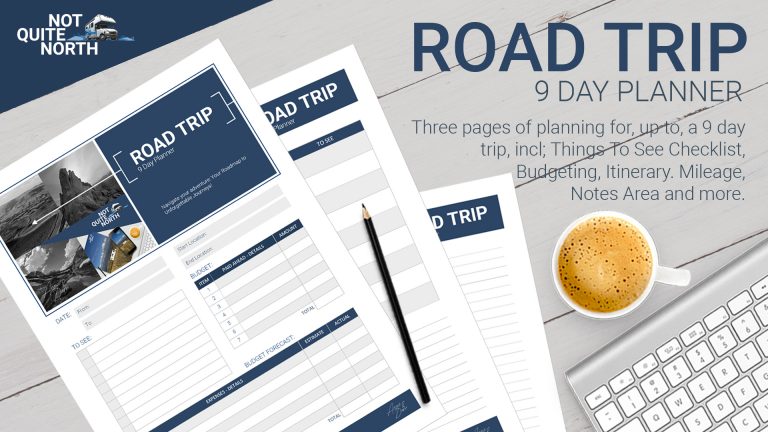
*Road Trip Planner
*By downloading our planner, you give us permission to send you our newsletter. We send this approx every 6 – 8 weeks.
When to Visit For Your Road Trip in France
For a motorhome road trip in France, the best time to visit really depends on what you’re looking for in your adventure. For us, we prefer to find the warmer weather, with longer days and milder evenings, but there is some great skiing to be had in France, which of course means a winter break is the best.
France in Springtime
Spring in France is a great time for a road trip. The weather is getting warmer, and the landscape is blooming. Plus, it’s before the summer rush, so places are less crowded. You’ll get to enjoy the beauty of places like Provence with its lavender fields starting to bloom towards the end of this period without too many people around.
France in Summer
If you love sunshine and don’t mind the crowds, summer is peak season. It’s perfect for beach destinations along the French Riviera. However, it’s also when France is busiest, and prices for campsites can be higher.
Autumn in France
The weather is still nice, especially in September. This is harvest time in wine regions like Bordeaux or Burgundy, making it an excellent choice for wine enthusiasts. The autumn colors are beautiful, and the tourist crowds have thinned out.
France in Winter
It’s the off-season for most of France, except for the Alps and Pyrenees, where it’s peak ski season. If you don’t mind the cold and enjoy winter sports, it’s a great time. Plus, you’ll see the Christmas markets in December.
We would avoid the south of France in the summer months just because of the crowds, but of course, you can always avoid the crowds by going to non-tourist places – France is about 2.5 times the size of the UK – with about the same number of people living in it.
France also has a lot of festivals in the summer which may influence the time you want to go.
In summary, if you prefer mild weather and fewer people, spring and fall are the best. For beach weather and lively festivals, choose summer. Winter is great for skiing or enjoying France’s cities without the crowds. It all comes down to your personal preferences and what you want to experience on your road trip.
France since Brexit - What's Changed?
Since Brexit, a number of things have changed with regards to travelling to France. The legal requirements for entry are obviously the biggest one. France is part of the Schengen Region. This is not the same as the EU or Europe! These are common mistakes people make.
Being part of the Schengen means that UK citizens with British passports can only be in the Schengen region for 90 days out of 180 days. It can be difficult to keep track of – but thankfully there are many apps that can help you with that. It is more complicated than it first sounds – and the penalty for this is can be a ban – a pretty significant event, considering there are 27 member countries of the Schengen. Check out our article for ‘The Schengen Shuffle’ to find out how to manage the impact of this for fulltime travellers. Try and keep a few days in your back pocket just in case something goes wrong.
You don’t need a visa as of now, but in 2025 you will need an EITAs – an online registration system that is being introduced.
You will need to apply for a GHIC health insurance card to cover you for basic hospital cover either free or low cost – but it is best practice to get yourself travel insurance when you are travelling to France. Medical costs can run into their thousands so it really is recommended.
As a result of Brexit, your mobile phone roaming fees will likely be affected. So you will need to either pay a daily roaming fee (in most cases) or swap out your sim card for a local card which will give you access to data/calls etc.
Last but not least – the pet passports have changed. Instead of a pet passport, you will need to apply for an Animal Health Certificate (AHC) which confirms that your pet is microchipped and has an up-to-date rabies vaccination. You need to get a new certificate each time you travel within 10 days of your travel date. This will be valid for 4 months.
France Itineraries and Information
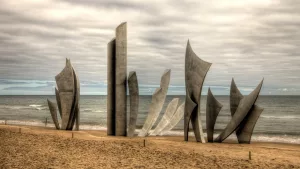
Searching for a quick getaway, but want to go across the channel? We have 5 roadtrip ideas for northern France, which will make you go ‘ooh la la!’ My particular favourite is the Champagne trail!
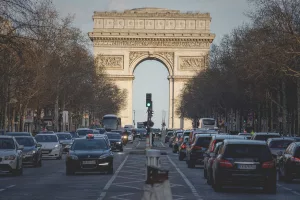
Everything you need to know about the rules on driving in France. From speeds, drink driving rules, wild camping and even the speeding fines. Driving essentials in one place.
Traditional Foods In FRANCE
What is there to say about French food? This famous fine dining cuisine can be whatever you want it to be. The number of Michelin starred restaurants offering the most exquisitely presented food can be found all over (630 of them to be precise – as of 2024).
We are way more practical than that! Whilst we love a good fine dining experience – we are very much more about local and traditional foods to try. Foods of the regions interest us. Every area will have its own speciality – Epernay & Champagne are a match made in heaven for example.
French Onion Soup – a delectable bowl of hearty French onion soup is hard to beat. An 18th century dish, made with onions and beef broth, served with a big chunk of toasted bread on top finished with grated cheese lightly grilled. It was known as ‘Drunkard Broth’ as it masked the smell of alcohol! I have made this before and it took about 3 hours! Went down a storm!
Bouillabaisse – a favourite of my dads and my sons! A soup which is from the south of France – mainly made with fish, shellfish and vegetables in broth. The spices used in it give it the real flavour, although the dish is so old (2,500 years apparently!) it is hard to know what is totally authentic, but if you are around Marseille, this is the originating city.
Croque monsieur – available in cafe’s all over France – the traditional cheese and ham toasted sandwich. Thought to have originated from Parisian cafes in the 1900’s, the croque monsieur is in essence a ham and cheese sandwich with bechamel sauce (both inside and on top) with the top layer having grated gruyere cheese on it, melted under the grill. Yum!
Escargots de Bourgogne – we couldn’t not mention snails could we? For the older people or film fanatics – remember Julia Roberts with her ‘slippery little suckers’ phrase? Escargot de Bourgogne are classic snails in garlic and parsley butter. If you get a chance – look for a snail farm whilst you are in France – get right to the source. Snails with garlic are totally delicious.
Last but not least – the humble Croissants. Can’t get much more classic that this finest of pastries served for breakfast. OK – not unusual these days – but you will surely taste the difference from the fine pastry selections that you can pick up from the local ‘boulangerie’, deliciously buttery and flaky. I always eat twice as many – so bad for the waist line!
We hope you enjoyed this article and found it useful. If you found it useful, please do share with others using the share buttons below. If you think we have missed something – please do let us know. We read all our emails!



